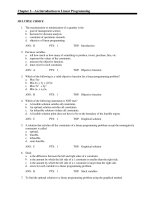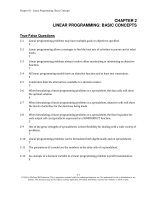Introduction to management science 10e by bernard taylor chapter 13
Bạn đang xem bản rút gọn của tài liệu. Xem và tải ngay bản đầy đủ của tài liệu tại đây (5.35 MB, 61 trang )
Decision Analysis
Chapter 12
Copyright © 2010 Pearson Education, Inc. Publishing as
Prentice Hall
12-1
Chapter Topics
■ Components of Decision Making
■ Decision Making without Probabilities
■ Decision Making with Probabilities
■ Decision Analysis with Additional Information
■ Utility
Copyright © 2010 Pearson Education, Inc. Publishing as
Prentice Hall
12-2
Decision Analysis
Components of Decision Making
■ A state of nature is an actual event that may
occur in the future.
■ A payoff table is a means of organizing a decision
situation, presenting the payoffs from different
decisions given the various states of nature.
Copyright © 2010 Pearson Education, Inc. Publishing as
Prentice Hall
Table 12.1 Payoff
Table
12-3
Decision Analysis
Decision Making Without
Probabilities
Figure 12.1
Copyright © 2010 Pearson Education, Inc. Publishing
as Prentice Hall
12-4
Decision Analysis
Decision Making without
Probabilities
Table 12.2
Decision-Making Criteria
maximax
minimax
maximin
minimax regret
Hurwicz
Copyright © 2010 Pearson Education, Inc. Publishing as
Prentice Hall
equal
12-5
Decision Making without
Probabilities
In the maximax
criterion the decision maker
Maximax
Criterion
selects the decision that will result in the
maximum of maximum payoffs; an optimistic
criterion.
Table 12.3 Payoff Table Illustrating a
Maximax
Decision
Copyright © 2010 Pearson Education, Inc. Publishing
as
Prentice Hall
12-6
Decision Making without
Probabilities
Maximin
Criterion
In the maximin
criterion the decision maker
selects the decision that will reflect the
maximum of the minimum payoffs; a
pessimistic criterion.
Table 12.4 Payoff Table Illustrating a
Copyright © 2010 Pearson Education, Inc. Publishing as
Maximin Decision
Prentice Hall
12-7
Decision Making without
Probabilities
Minimax
Regret
Criterion
Regret is the
difference
between the payoff
from the best decision and all other decision
payoffs.
The decision maker attempts to avoid regret by
selecting the decision alternative that
minimizes the maximum regret.
Table 12.6
Regret Table Illustrating the Minimax
Regret Decision
Copyright © 2010 Pearson Education, Inc. Publishing as
Prentice Hall
12-8
Decision Making without
Probabilities
Hurwicz Criterion
The Hurwicz criterion is a compromise between
the maximax and maximin criterion.
A coefficient of optimism, , is a measure of the
decision maker’s optimism.
The Hurwicz criterion multiplies the best payoff
by and the worst payoff by 1- ., for each
decision, and the best result is selected.
Decision
Apartment building
30,000(.6) = 38,000
Office building
= 16,000
Copyright © 2010 Pearson Education, Inc. Publishing as
Prentice Hall
Warehouse
Values
$50,000(.4) +
$100,000(.4) - 40,000(.6)
12-9
$30,000(.4) + 10,000(.6)
Decision Making without
Probabilities
Equal Likelihood Criterion
The equal likelihood ( or Laplace) criterion
multiplies the decision payoff for each state of
nature by an equal weight, thus assuming that
the states of nature are equally likely to occur.
Decision
Apartment building
30,000(.5) = 40,000
Office building
= 30,000
Warehouse
= 20,000
Copyright © 2010 Pearson Education, Inc. Publishing as
Prentice Hall
Values
$50,000(.5) +
$100,000(.5) - 40,000(.5)
$30,000(.5) + 10,000(.5)
12-
Decision Making without
Probabilities
Summary of Criteria Results
■ A dominant decision is one that has a better
payoff than another decision under each state
of nature.
■ The appropriate criterion is dependent on the
“risk” personality and philosophy of the
decision maker.
Criterion
(Purchase)
Decision
Maximax
Office building
Maximin
Apartment building
Minimax regret
building
Copyright © 2010 Pearson Education, Inc. Publishing as
Prentice Hall
Hurwicz
Apartment
Apartment building
12-
Decision Making without
Probabilities
Solution with QM for Windows (1 of
3)
Copyright © 2010 Pearson Education, Inc. Publishing as
Prentice Hall
Exhibit
12.1
12-
Decision Making without
Probabilities
Solution with QM for Windows (2 of
3)
Copyright © 2010 Pearson Education, Inc. Publishing as
Prentice Hall
Exhibit
12.2
12-
Decision Making without
Probabilities
Solution with QM for Windows (3 of
3)
Copyright © 2010 Pearson Education, Inc. Publishing as
Prentice Hall
Exhibit
12.3
12-
Decision Making without
Probabilities
Solution with Excel
Copyright © 2010 Pearson Education, Inc. Publishing as
Prentice Hall
Exhibit 12.4
12-
Decision Making with Probabilities
Expected Value
Expected value is computed by multiplying
each decision outcome under each state of
nature by the probability of its occurrence.
Table
12.7
30,000(.4)
=
EV(Apartment) = $50,000(.6) +
42,000
EV(Office) = $100,000(.6) - 40,000(.4) = 44,000
Copyright © 2010 Pearson Education, Inc. Publishing as
= $30,000(.6) + 10,000(.4) =12Prentice EV(Warehouse)
Hall
Decision Making with Probabilities
Expected Opportunity Loss
■ The expected opportunity loss is the expected
value of the regret for each decision.
■ The expected value and expected opportunity
loss criterion result in the same decision.
EOL(Apartment) = $50,000(.6) + 0(.4) = 30,000 Table
EOL(Office) = $0(.6) + 70,000(.4) = 28,000
12.8
EOL(Warehouse) = $70,000(.6) + 20,000(.4) = 50,000
Copyright © 2010 Pearson Education, Inc. Publishing as
Prentice Hall
12-
Expected Value Problems
Solution with QM for Windows
Copyright © 2010 Pearson Education, Inc. Publishing as
Prentice Hall
Exhibit
12-
Expected Value Problems
Solution with Excel and Excel QM (1
of 2)
Copyright © 2010 Pearson Education, Inc. Publishing as
Prentice Hall
Exhibit
12.6
12-
Expected Value Problems
Solution with Excel and Excel QM (2
of 2)
Copyright © 2010 Pearson Education, Inc. Publishing as
Prentice Hall
Exhibit 12.7
12-
Decision Making with Probabilities
Expected Value of Perfect
Information
■ The expected value of perfect information
(EVPI) is the maximum amount a decision
maker would pay for additional information.
■ EVPI equals the expected value given perfect
information minus the expected value without
perfect information.
■ EVPI equals the expected opportunity loss
(EOL) for the best decision.
Copyright © 2010 Pearson Education, Inc. Publishing as
Prentice Hall
12-
Decision Making with Probabilities
EVPI Example (1 of 2)
Table 12.9
Payoff Table with Decisions, Given Perfect
Information
Copyright © 2010 Pearson Education, Inc. Publishing as
Prentice Hall
12-
Decision Making with Probabilities
EVPI Example (2 of 2)
■ Decision with perfect information:
$100,000(.60) + 30,000(.40) = $72,000
■ Decision without perfect information:
EV(office) = $100,000(.60) - 40,000(.40) =
$44,000
EVPI = $72,000 - 44,000 = $28,000
EOL(office) = $0(.60) + 70,000(.4) = $28,000
Copyright © 2010 Pearson Education, Inc. Publishing as
Prentice Hall
12-
Decision Making with Probabilities
EVPI with QM for Windows
Exhibit 12.8
Copyright © 2010 Pearson Education, Inc. Publishing as
Prentice Hall
12-
Decision Making with Probabilities
Decision Trees (1 of 4)
A decision tree is a diagram consisting of
decision nodes (represented as squares),
probability nodes (circles), and decision
alternatives (branches).
Table 12.10 Payoff Table for Real Estate
Investment Example
Copyright © 2010 Pearson Education, Inc. Publishing as
Prentice Hall
12-









